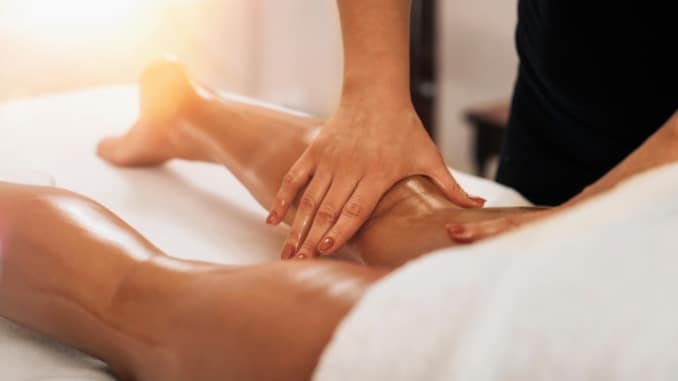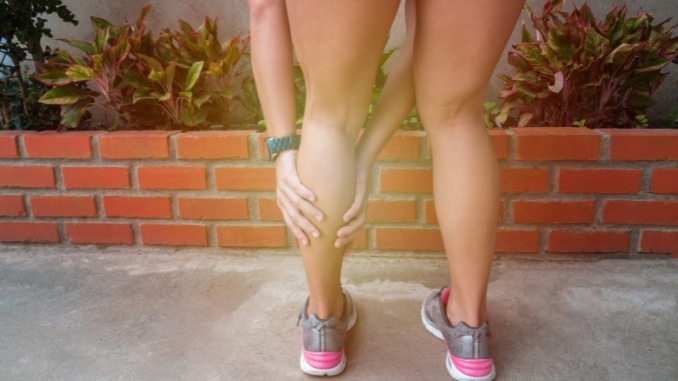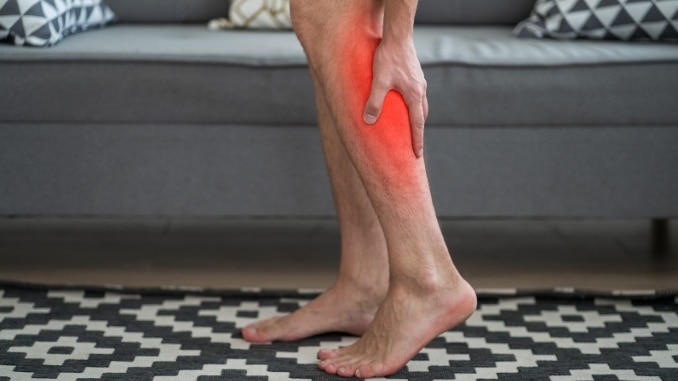Calf pain can strike out of nowhere—whether you’re mid-run, fresh off a long flight, or simply walking up stairs. That sharp pain, dull ache, or muscle cramp in your lower leg could be your body’s way of saying, “Slow down.” But what causes it? And more importantly, how can you relieve it quickly and prevent it from coming back?
Before diving into the causes, symptoms, and treatment options, let’s start with what you can do right now to reduce calf muscle pain [1] and restore comfort to your stride.
These stretches and strengthening moves are ideal for relieving tension, increasing blood flow, and preventing future calf muscle strain.
1. Foam Rolling Out the Calf
- You can use a 1-foot foam roller to reduce calf pain and tightness.
- Sit on the floor, flexing your right knee.
- Lift your left leg, placing your heel above the foam roller.
- Prop yourself up with your arms, roll below your knees, and roll back to the calf area.
- You may feel some sensitive areas.

We are working on decreasing the tension in the calf area. We are working on elongating the tissue, addressing overactive muscle fibers, and dealing with trigger points. This will elongate and decrease tension, resulting in less pulling in the calf area.
1a. Rotating Legs Inward
Same as above, but turn your leg inward and then roll through.
Turning the leg inward will target the working of the medial or inner part of the calf.
1b. Rotating Legs Outward
Same as above, but turn the leg outward and then roll through.
Turning the leg outward will target working more on the lateral or outer part of the calf will ease your calf pain and tightness.
Perform one set of 5 reps in a smooth, controlled movement with the intensity of a massage. We do not want screaming pain because if you irritate the tissue, it will do the exact reverse. It will tighten up more and lead to more pain.
Alternative to foam roller: Medicine ball, soccer ball, or basketball
2. Calf Stretch
- In a standing position, take a big step forward with your toes pointing straight ahead.
- Most of your weight should be on the front foot, keeping your heel on the back foot down to get a stretch in the calf area.

In this stretch, we target the calf area where you feel the stretch may differ depending on where you have tension or tightness.
To avoid calf pain and tightness, perform one set of 2 reps on each side, with a 20-second hold and intensity of a light stretch, alternating back and forth. Be sure to stretch the non-injured side as well to aid in prevention.
3. Heel Drops Reduce Calf Pain and Tightness
Use a step, either a foam roller or the bottom step of the stairs.
- Place the balls of your feet on the step.
- Place your hands on the wall or railing for balance.
- With your ankles straight, drop your heels down.
This is a dynamic stretch to the calves.
Perform one set of 5 reps in a smooth, controlled movement, holding that bottom position for 2 seconds, with the intensity of feeling a good stretch.
Give these exercises a go to overcome the dull pain in your calf, just above your ankles.
What Causes Calf Pain?
Calf pain can result from a variety of issues, ranging from minor to severe. Common causes include:
- Muscle cramps from [2] dehydration, overuse, or prolonged sitting
- Calf muscle strain due to intense exercise, improper warm-up, or sudden movement
- Achilles tendonitis [3] or inflammation near the back of the ankle
- Nerve issues like sciatic nerve irritation or diabetic peripheral neuropathy
- Circulatory problems such as deep vein thrombosis (DVT) or varicose veins
- Compartment syndrome, a rare but serious condition that limits blood flow
- Injuries like a direct blow to the calf or a complete tear of the muscle
Symptoms of Calf Muscle Strain

A calf strain typically causes:
- A sudden sharp pain or pop in the back of the leg
- Swelling or bruising in the calf
- Difficulty walking or standing on toes
- Muscle stiffness or tightness in the lower leg
- A dull ache that worsens with movement
“One of the most common reasons people experience calf pain is due to poor flexibility and overuse, especially when they suddenly increase activity without properly conditioning their muscles. Calf muscles, particularly the gastrocnemius and soleus, are heavily involved in walking, running, and jumping. Regular stretching and strengthening—along with adequate hydration—are essential for preventing strain and reducing pain.” Dr. Jordan Metzl, MD, Sports Medicine Physician at Hospital for Special Surgery, New York City.
Home Remedies for Calf Pain Relief
Treat mild to moderate calf pain at home with these proven remedies:
1. R.I.C.E. Method
- Rest: Stop physical activity that causes pain.
- Ice: Apply cold packs for 15–20 minutes several times a day.
- Compression: Use a compression sleeve or wrap.
- Elevation: Prop your leg up to reduce swelling.
2. Heat Therapy
Use a warm compress or heating pad to soothe tight calf muscles once the acute swelling subsides.
3. Massage Therapy

Gently massage the calf to boost circulation and ease muscle tension.
4. Hydration + Electrolytes
Stay hydrated to prevent leg cramps, especially in hot weather or after intense exercise.
5. Over-the-Counter Pain Relief
Anti-inflammatories like ibuprofen can help reduce calf muscle pain and inflammation.
How Is Calf Pain Treated?
If at-home care doesn’t provide pain relief or if symptoms worsen, treatment may include:
- Physical therapy to improve strength, flexibility, and reduce future calf injuries
- Ultrasound or electrical stimulation to encourage healing in the surrounding tissue
- Supportive footwear or orthotics to reduce stress on the lower leg
- Prescription medications for severe pain or inflammation
- Surgery, only in extreme cases, like a torn Achilles tendon or compartment syndrome
When Should I See a Doctor?
You should see a doctor immediately if you have calf pain:
- Is severe and sudden, especially after intense physical activity
- Is accompanied by swelling, redness, or warmth (possible blood clot)
- Causes toes to swell, numbness, or signs of nerve damage
- Occurs after a direct blow to the calf muscle
- Includes chest pain or shortness of breath (could signal DVT traveling to lungs)
Also, seek urgent medical attention if your calf pain feels:
- Persistent or worsening despite rest
- Accompanied by signs of infection or fever
- Connected to underlying health conditions like diabetes or vascular issues
How to Prevent Calf Pain in the Future

Avoid future lower leg pain with these preventative steps:
- Warm up before workouts to boost blood flow to leg muscles
- Gently stretch your calves after exercise.
- Stay hydrated and replenish electrolytes during activity
- Wear proper shoes with arch support
- Avoid prolonged sitting—stand, walk, and stretch regularly
- Incorporate strengthening exercises for the calves, hamstrings, and other muscles.
Final Word
Whether it’s a dull ache after a workout or sudden pain that stops you in your tracks, calf pain can affect everything from your mobility to your mood. Fortunately, understanding the causes and using smart home treatments can make a big difference.
How can we reduce calf pain effectively? Start with the stretches above, stay alert to warning signs, and don’t hesitate to get professional help when needed. Your calves work hard—give them the care they deserve.
If you are looking for a fast, simple, safe, and effective program to eliminate stubborn knee pain and patellofemoral syndrome. Check out the Patellofemoral Syndrome Solution Program now!
Frequently Asked Questions
What is the fastest way to relieve calf pain?
Apply the R.I.C.E. method: Rest, Ice, Compression, and Elevation. Combine this with gentle stretching, hydration, and over-the-counter anti-inflammatory medication if needed. For tight calf muscles, try heat therapy or foam rolling to increase blood flow and ease muscle tension.
Can dehydration really cause calf cramps?
Yes. Muscle cramps and calf pain often result from dehydration and low electrolyte levels, especially after intense exercise or heat exposure. Stay hydrated and consider supplementing with magnesium or potassium to help prevent leg cramps.
How do I know if my calf pain is serious?
If you experience sudden, severe pain, notice swelling, redness, or warmth, or feel pain when walking or have swollen toes, seek medical attention. These could indicate a blood clot, calf strain, or Achilles tendon injury. If the pain is paired with chest pain or shortness of breath, go to the emergency room immediately.
Why does my calf hurt when I wake up or after sitting too long?
Prolonged sitting or sleeping in certain positions can reduce blood flow and cause muscle stiffness. This may trigger calf cramps or soreness upon movement. To prevent this, gently stretch your leg muscles before going to bed or after sitting for long periods.


